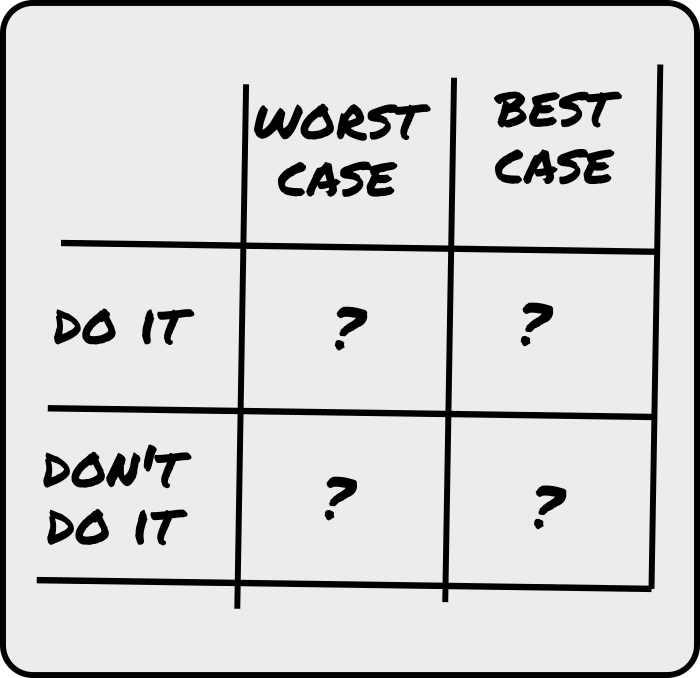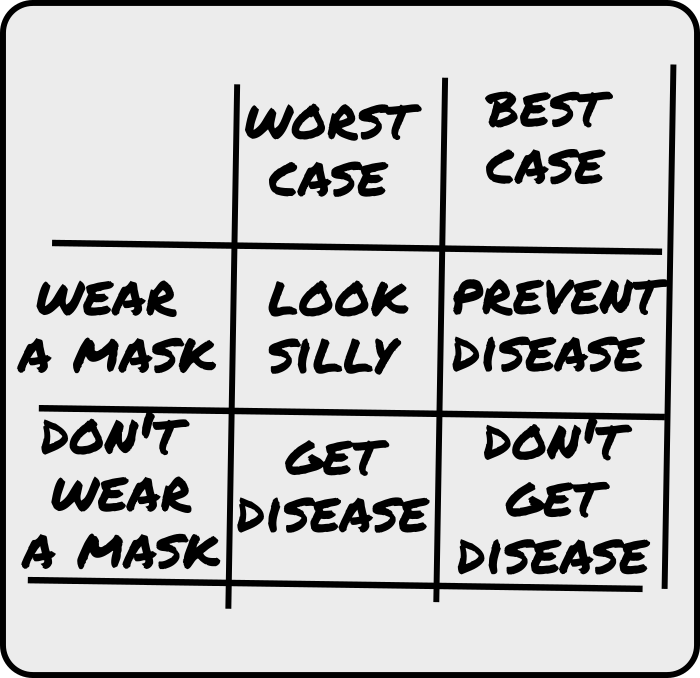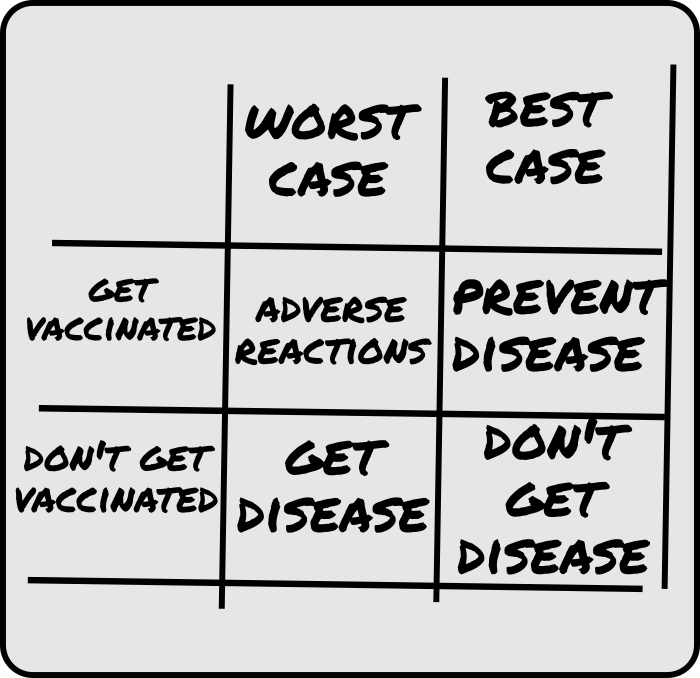Using a Threat Matrix for Decision Making
This site utilizes Google Analytics, Google AdSense, as well as participates in affiliate partnerships with various companies including Amazon. Please view the privacy policy for more details.
Do I wear a mask or not? Should I get a vaccine or not? Should I… or shouldn’t I? And how do I decide?
I have a system I use for such binary decisions - what I call the threat matrix. Essentially I take a binary choice and consider the best-case and worst-case scenarios for each.
Each threat matrix is a two-by-two matrix (if you’re not including headings) that looks like the following:

It’s a bit like a decision matrix with one important constraint: its size is never to exceed two-by-two.
One side is always a binary choice - typically do the thing or don’t do the thing. The other side is always best case and worst case.
Why this limitation? Anything larger increases the cognitive load - it gets more confusing as to what the possibilities are. Average case, mean case, median case? Bah - throw them all out. we’ll find out later that, for decision-making purposes, they’re useless.
Let’s dive into a couple of real-world examples.
Real-World Threat Matrix 1: Masks
In the world of 2020, we have the coronavirus pandemic. One thing people are encouraged to do is to wear a mask.
So should I wear a mask in public? Let’s use my threat matrix to decide:

If I wear a mask, what’s the worst thing that can happen? I’ll look silly - perhaps be the butt of a few people’s jokes.
But if I wear a mask, what’s the best thing that can happen? I don’t contract the disease - or, if I’m already sick - I don’t spread the disease.
Let’s look at my other option - don’t wear a mask. If I don’t wear a mask, what’s the worst thing that could happen? I could get the disease.
The best thing that could happen if I don’t wear a mask is I don’t get the disease.
Note that these aren’t necessarily what everyone would put for best case/worst case. Also, masks aren’t 100% effective, so the best case for wearing masks is (somewhat) unrealistic. But remember, we’re not looking for average case.
Based on my threat matrix, I’ve concluded I should wear a mask in public. Your conclusions might be different.
Keep in mind my decisions are independent of any outside decision-maker, e.g. local or state ordinances. My decision should be the same whether masks are mandated or prohibited.
Real-World Threat Matrix 2: Vaccines
Now let’s look at the ever-controversial world of vaccines:

Should I get a vaccine or not? Well, if I do get a vaccine, the best case is I’ll never get the disease the vaccine is trying to prevent. Worst case? I’ll have an adverse reaction - typically some sort of allergic reaction - that could be anything from as mild as a sore at the injection site to a severe as death.
But if I don’t get the vaccine, I could possibly contract the disease. That’s the worst case. Best case? For whatever reason, I may never get the disease.
Here’s where things may get a little trickier. I may ask myself: what is the probability of getting whatever disease the vaccine is trying to prevent? How bad is the disease? What are the odds of me getting an adverse reaction?
If I can decrease the chances of an adverse reaction - for instance, knowing that I am not allergic to any of the vaccine’s ingredients, or taking only vaccines that are tried-and-true and thus recommended by medical doctors - I can reduce or eliminate that quadrant of the threat matrix, thus making the decision to get a vaccine the “right” one.
And So?
The core reason I keep my threat matrices small is that I never write them down. This post is the first time I’ve done anything more than visualize them in my head.
I also want the options to be simple, so the do it/don’t do it axis needs to be opposites, which is normally easy enough.
Can you think of any other examples of using threat matrices in decision making? Do you use something else to help you come to decisions? Be sure to comment below!
Leave a Reply
